The media picks up the tag line "India puts up a missile shield" every time there is news related, one way or the other, to the plan to acquire a surface-to-air-missile (SAM) system. The so called "missile shield" filled the media space when there was a talk of S-400 system. The same was all over again, when the Defence Acquisition Council (DAC) accorded the acceptance of necessity (AoN) for the procurement of national advanced surface-to-air (SAM) missile system II ( NASAMS II) from USA .

This article tries to make sense of the oft quoted term "missile shield" by presenting to a discerning reader, the various dimensions related to the issue.
The Eternal Cause Effect Relationship
SAMs, or for that matter, the entire family of air defence weapons on land sea and air exist for the sole purpose of countering the air threat by the adversary.
The term 'air threat’ essentially implies the cumulative potential danger which our adversary holds, as his capability to cause damage and destruction to our vulnerabilities through the use of aerial threat vehicles and munitions in furtherance of, or in support of his war effort.
This danger is basically assessed in two dimensions. First is the qualitative dimension, which includes the lethality, severity and technological advancement of the adversary's air threat vehicles, while the second, is the quantitative dimension that relates to the numbers which constitute the air threat punch. Accordingly, the defender aims to put together such resources on land, sea and air that can counter the threat as defined above. Thus the air threat on one side and the air defence means on the other are tied to each other in an eternal cause-effect relationship.
How the Air Threat got Revamped Over Time
The multi-dimensional growth of the air threat over time has mainly taken place along two major verticals. The first of these is the "multiplicity of air threat vehicles". In that, the erstwhile duo of aircrafts and helicopters as main threat vehicles, are today joined by a multi-dimensional strike punch consisting of attack helicopters, unmanned aerial systems/vehicles (UAS/UAVs), tactical ballistic missiles, cruise missiles, precision guided munitions (PGMs), anti-radiation missiles (ARMs) and the now emerging soft-kill offensive weapons.
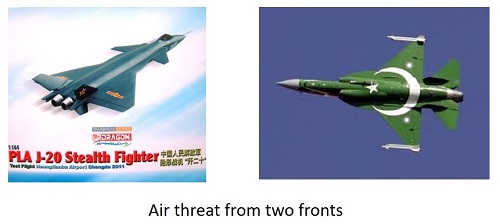
The second vertical is the "spatial growth of the threat" in all its three dimensions of range, reach (implying altitude) and hours of applicability. Starting from, say, early seventies when the air threat was prosecuted mainly in the visual domain of the defenders by using mostly short range guns and a small arsenal of unguided rockets and missiles, today, the capability is to strike deep with precision and accuracy from long ranges standing off hundreds of miles away from the defenders' visual domain. Also to strike with multiple threat vehicles at any time of the day or night, remain nearly invisible to defenders' radars, employ the UAS with its multiple combat virtues and to hit both with hard and soft-kill munitions are other signature features of the air threat of today.
Prosecution of the Threat
The prosecution of the air threat as stated above is spread over the entire spectrum of multiple threat vehicles. Today, the 4th and 5th generation war machines are truly multi-role, structurally lighter, detection resistant, carry an array of on-board sensors with a packaged electronic warfare (EW) suit for survivability and sustainability and are armed to the teeth with smart and intelligent munitions including the PGMs.
The attack helicopters have become all weather with avionics providing the technological muscle for nap-of-earth operations. The unmanned revolution has taken over with its unmatched capability of all weather, all terrain operations with incredible endurance and no crew fatigue and multiplicative affects are being achieved by manned and unmanned teaming. The missiles, both in the surface-to-surface (SSM) and air-to-surface (ASM) modes are scaling new dimensions in range, reach and kill probabilities and the soft-kill weapons are emerging in three domains, viz, laser, charged particle beams and high power microwaves. That briefly is a glimpse of the challenge that the air defence weapons have to face today and in which, the term "missile shield" must find its place.
Much like the prosecutors of the air threat, the story in the defenders camp has also evolved over decades in keeping up the spirit “for every sword a shield". This is how it has unrolled. In early days with only aircrafts and helicopters to guard against and that also in fair-weather and only against such munitions as front guns and unguided bombs and rockets. The air defence challenge was not as grave. Also, the Vulnerable Areas/Points (VAs/VPs) to be protected by air defence weapons were limited and essentially required fair weather weapons.
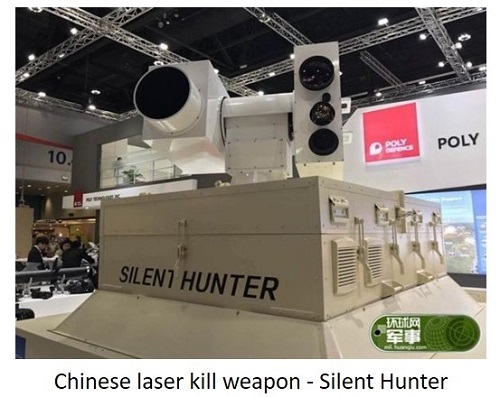
(Source: https://www.popsci.com/china-new-weapons-lasers-drones-tanks)
It was thus considered appropriate to deploy multiple rings of terminal air defence guns around the vulnerabilities to be protected in the 'point defence' mode or go for 'carpet layouts' (increasing densities of guns) where the VA/VP was that critical. Such a scalar defence is totally dysfunctional in the current threat environment. Today, since the multiple threat vehicles can strike our vulnerabilities from very long ranges right up to the terminal end, the basic requirement is to inflict ‘continuous punishment’ to the attacker as it transits from long ranges to the end-game. This punishment has to be all weather, seamless and must switch from weapon-to-weapon (long to medium to short to very short range) cutting across Service boundaries. For meeting the above requirement a need was felt to deploy a series of SAMs from long to medium to short range patching up on the erstwhile point defence weapons at terminal end (called very short range air defence systems, or VSHORADS).
The SAM, by virtue of their ranges and altitudes covered various layers. Such a deployment was therefore called layered-and-tiered defence. Taken together with their associated sensors and battle management command and control (BMC2) systems, it was called the integrated air defence system or IADS for short.
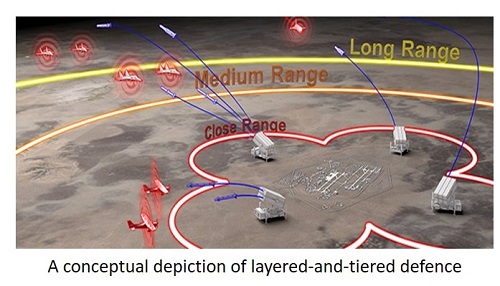
(Source:https://steamcommunity.com/sharedfiles/filedetails/?id=349506146)
The IADS Today
Today the IADS anchored on the trio of ‘sensors’, ‘shooters’ and ‘BMC2 systems’ creates an area air defence capability on a theatre grid. The sensors span the entire spectrum of frequency bands to optimise their multiple functions of early warning, target designation, missile guidance, and fire control of guns et al, besides packing such capabilities as to detect stealthy targets and survive in a hostile electronic warfare environment.
The shooters comprise of the entire pack of aircrafts and missiles. The IADS as a whole is capable of providing area air defence to large swaths of areas in which the individual weapons provide air defence in their effective range and reach envelopes as a part of layered-and-tiered defence. The BMC2 system features the best in communication and data transfer technology providing for the complex interrelated functions of detection of targets, fusing of inputs of multiple sensors to cut out duplication, recognition of detected targets as friendly or hostile (identification friend or foe or IFF), creation of recognised air situation picture (RASP), prioritisation of the threat as to its immediacy and lethality, selection of weapons for punishment, designation of targets to the selected weapons, seamless switching of fire from weapon-to-weapon and exercising minute-to-minute control over air defence battle.
Besides this, the system also addresses a huge vertical of air space control wherein, finite resource of air space is allowed to be used by its multifarious users with minimum restrictions and maximum freedom of action and avoiding fratricide at all costs. Keeping the current realities in mind where multiple systems of different makes and genres populate the battle space at the same time, another capability of the BMC2 system is to knit dissimilar systems in one seamless voice and data loop through common data links or CDL.
Missile Shield
It is against the above backdrop, that the so called ‘missile shield’ has to find its place.
Basically, whenever a SAM system is on a line of planning for procurement or actually gets inducted, it will fit itself in the hierarchy of SAMs which taken as a whole, is loosely referred to as missile shield. There is also another misnomer of portraying every SAM as capable of taking on enemy's SAMs and making such claims as "the so called missile shield will not let any adversary's SAM enter into our air space (impregnable)”.
Firstly, it is to be understood that own SAMs do not defeat adversary's SAMs, it our Ballistic Missile Defence System (BMD) that will defeat enemy's SAMs and secondly, it is stated that no shield is impregnable. A determined attacker pressing his attack in quality (avoiding radar detection) and quantum (overwhelming the IADS's target handling capability) will be able to penetrate this shield, hopefully to be attacked by the next layer. A constant battle thus rages between the prosecutors of the air threat and the valiant vayu rakshaks.
Specifics of the Missile Shield
Besides the terminal end VSHORADS (provided by towed and self-propelled guns and a series of very short range missiles) extending to 6-10 km, the balance of the missiles, namely the short range SAMs (20-30 km), medium range SAMs (70-100 km) and long range SAM (more than 100 km) constitute the current missile shield complete in three components of sensors, shooters and BMC2 system.
Besides this, the current BMD capability is promised to be provided by the Defence Research and Development Organisation (DRDO) wide its BMD programme, codenamed ‘Programme AD’. This programme is in two phases. Phase 1 is to provide a capability of taking on enemy's ballistic missiles up to a range of 2000 km, while Phase II is to enable the defenders in taking on the ballistic missiles up to ranges of 5000 km. The projected date of completion of phase 1 was 2012 and phase II by 2016. It is reported that while both the phases stand realised, it will take a few more years for phase II to be operationalised.
It is in this regime of IADS and BMD the S-400 will get into. Following points are notable:-
- It is reported that the plan is to procure of five Regiments of S-400 at a likely cost of $ 4.5 billion.
- S-400 has four interceptors with ranges from 40-400 km. This is a way higher capability from the existing range and reaches capability of IADS, as explained above.
- The system can cover huge swaths of area providing a degree of air defence cover to all the vulnerabilities located therein.
- S-400 is not only an air defence system, it is also an anti-missile system capable of providing effective defence against adversary's ballistic missiles. In this role, it will compliment the indigenous BMD system as mentioned above. In that, the fire units of S-400 and Progamme AD can be deployed in a complementary manner.
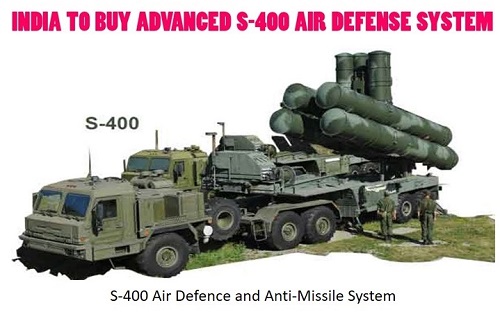
(Source: https://www.youtube.com/watch?v=MvuMp5AsnRA)
Another addition to the so called missile shield is the reported NASAM II which as stated, has been granted AoN by the DAC lately. The NASAM has interceptors with ranges from 55 to 180 km. With these ranges, the weapon system will bring considerable increment in the range and reach envelope of the current IADS. Though the open sources do not describe NASAMs II as an anti-missile system, should the system possess limited BMD capability, it could augment the Programme AD capability.
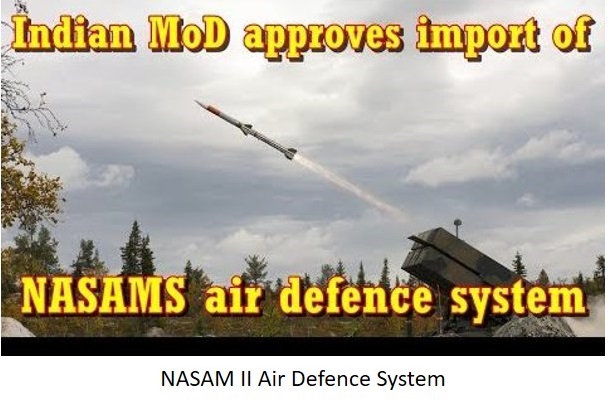
(Source: https://warfareweb.com/2018/08/01/indian-mod-approves-import-of-nasams-air-defence-system-youtube/)
Reality Check
Having stated the facts, some points of reality check are:-
Immediate Step
In their euphoria and rat race for breaking news and TRP, there is a tendency by the media to actually mis-inform people. In that, they project that the systems being talked about (S-400, NASAMS II etc) have arrived yesterday and being deployed today! With the contract for S-400 yet to be signed and NASAMs only at the AoN stage, it must be appreciated that the weapon systems are far into the future.
Suffice to say that even after all clear is given, the mere induction of the weapon as full-fledged fire units would take 2-4 years. Prior to this, there is a haul of several years (minimum 3-4) for the long-drawn procurement procedures, off-sets, transfer of technology (ToT) issues, selection of Indian public and private partners in joint ventures, etc. This is the reality of time which must not be sold as ‘immediate’.
On Integration
Systems like S-400, NASAMs II etc. are strategic systems. Integrating them properly in the eco-system of the existing IADS is a huge challenge. Their sensor systems need to get looped in our grid of early warning and tactical control, systems and thereby provide to it a huge qualitative jump in surveillance and target handing capability. Their interceptors have to seamlessly merge into our layered-and-tiered defence systems taking the ceiling of air defence and anti missile cover many notches up. Most importantly, their BMC2 systems have to have a ‘one-on-one’ and ‘one-on-many’ connect with our existing BMC2 system.
In this context, it is also pertinent to mention that the weapon systems like NASAMs II are totally dissimilar to the Russian systems, about 76 percent of which populate our air defence weapon inventory. In fact, these belong to a totally dissimilar NATO weapon philosophy. Integrating it with Russian dominant eco system it will be a huge issue.
Even for the Russian block S-400, while our existing BMC2 infrastructure belongs to one generation, S-400 will bring in a totally different generation. A mention has been made earlier of the common data links. These will have to be played up in a very big way to really absorb and amalgamate these systems as capability enhancers and not as stand-alone verticals. Even in the BMD domain, the linkages of S-400 and NASAMs will have to be established with Programme AD system.
Associated Structures
It is not the weapon alone that matters; the associated capabilities and infrastructures to realise the Indian portion of the responsibility in the work share, missile testing and storage sheds, repair and overhaul facilities, simulators, spare support for the life cycle of the weapon system and more, also has to be ensured.
Acquisition and Operation
While we are far away from the actual terms of contract which will decide how the weapon systems will actually materialise and what will be the Indian responsibility, a word of caution here is important - while deciding the Indian work share/responsibility and load in case of joint venture with ToT etc, it must be ensured that the finite capability of manufacturing of our public sector players or the technological threshold of the private industry must not get overwhelmed or overloaded. If this happens, the end result will have time and cost overruns at the expense of the user.
Finally, strategic systems like S-400 and NASAMs II should be under the domain of the Strategic Forces Command (SFC), like Programme AD is.
(The paper is the author’s individual scholastic articulation. The author certifies that the article/paper is original in content, unpublished and it has not been submitted for publication/web upload elsewhere, and that the facts and figures quoted are duly referenced, as needed, and are believed to be correct). (The paper does not necessarily represent the organisational stance... More >>
Image Source: https://4.bp.blogspot.com/-iX2NZHLB4zA/WC6vrCt3-DI/AAAAAAABBaQ/6s3xbhaVHZoPm_7T20l9G2hgIszog38SQCLcB/s1600/S-400_Triumf_Air_Defense_System_6.jpg


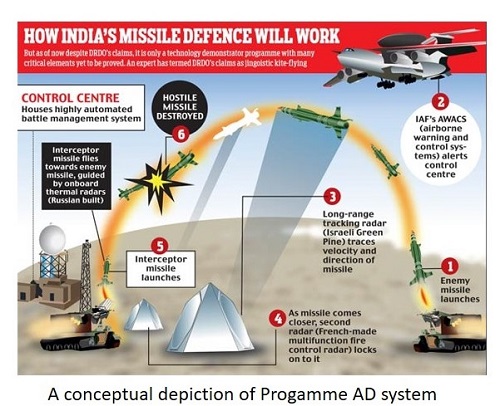








Post new comment